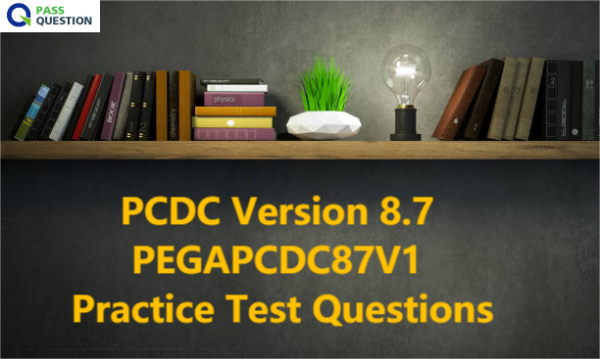PCDC Version 8.7 PEGAPCDC87V1 Practice Test Questions
If you want to clear the Certified Pega Decisioning Consultant (PCDC) 87V1 exam on your first attempt, you should consider using PassQuestion PCDC Version 8.7 PEGAPCDC87V1 Practice Test Questions. It will help you assess your preparation level and you will be able to make things easier and better for yourself. You will be able to receive high-quality and validated PCDC Version 8.7 PEGAPCDC87V1 Practice Test Questions that the experts create. Our experts are regularly updating exam content according to the market trend which helps you to pass the exam easily. It is highly recommended for you to go through our PCDC Version 8.7 PEGAPCDC87V1 Practice Test Questions multiple times so you can clear the exam on your first attempt.

PEGAPCDC87V1 Exam Overview - Certified Pega Decisioning Consultant (PCDC) 87V1
The Certified Pega Decisioning Consultant certification is for professionals participating in the design and development of a Pega Customer Decision Hub solution. This certification ensures you have the skills to apply the design principles of Next-Best-Action Designer, Decision Strategies, and Predictive Analytics. The exam includes multiple-choice, scenario, and drag/drop questions.
Exam Information
Exam Code: PEGAPCDC87V1
Type of Exam: 60-question exam
Length: 90 minutes
Passing Grade: 70%
Language: English | French
Prerequisites: Decisioning Consultant
Exam Objectives
Next-Best-Action concepts (9%)
- One-to-one customer engagement
- Optimize the customer value in the contact center
- Essentials of always-on outbound
- Define the starting population
Actions and treatments (14%)
- Define and manage customer actions
- Present a single offer on the web
- Define an action for outbound
Engagement policies (11%)
- Define customer engagement policies
- Create an engagement strategy
Contact policy and volume constraints (12%)
- Avoid overexposure of actions
- Avoid overexposure of actions on outbound
- Limit action volume on outbound
AI and Arbitration (9%)
- Action arbitration
- Action prioritization with AI
- Prioritize actions with business levers
Channels (11%)
- Real-time containers
- Create a real-time container
- Send offer emails
- Share action details with third-party distributors
Decision strategies (26%)
- Create and understand decision strategies
- Create engagement strategies using customer credit score
- Create eligibility rules using customer risk segments
Business agility for 1:1 customer engagement (9%)
- Agility in a customer engagement project
- Change management process
- Building your business operations team
- Life cycle of a change request
- Change request types
- Launching a new offer on web
- Updating existing actions
- Implementing business changes in revision management
View Online PCDC Version 8.7 PEGAPCDC87V1 Free Questions
Which two of these statements is true about creating segments? (Choose Two)
A. The list of customers in a segment can be viewed from within the segment
B. A segment run can be triggered by the Next-Best-Action outbound schedule
C. In a segment you can reference customer properties OR another segment, but not both.
D. When building the segment, if you want to know the count resulting from the criteria defined so far, the only way to do this is by running the segment.
E. The result of a criteria group can be combined with the result above it using AND and OR operators.
Answer: AB
U+ Bank has decided to present the Platinum Plus credit card, a lower ranked card, to customers who visit their home page. Which arbitration factor do you configure to implement this requirement?
A. Business levers
B. Context weighting
C. Propensity
D. Action value
Answer: A
U+ Bank has a product eligibility matrix that defines what type of customers qualify for which offers when customers visit the bank's website.
Which two components in the Next-Best-Action Designer allows you to define these conditions? (Choose Two)
A. Arbitration
B. Channels
C. Engagement Policy
D. Constraints
Answer: CD
A bank has chosen an email service provider to deliver the offer messages selected by Pega Customer Decision Hub.
The service provider prefers that the bank uploads a file per batch of customers to a cloud storage location, either on Microsoft Azure or Amazon S3.
As a consultant working on the project representing the bank, what is your response?
A. Action details can only be transferred via secure FTP.
B. Action details will be written to the local filesystem by default. But we will write an external process to transfer them to the cloud.
C. Action details can be written directly to Amazon S3 but not Microsoft Azure.
D. Action details can be directly written to either of those cloud storage solutions.
Answer: D
In a decision strategy, to use a customer property in an expression, you _______________.
A. use the property as defined without any prefix
B. prefix the property with the keyword Customer
C. define Customer page in Pages and Classes
D. define the property as a strategy property
Answer: B
What does a dotted line from a Group By component to a Filter component mean?
A. Information from the Group By component is copied over to the Filter component.
B. The Filter component references a property from Group By component.
C. Evaluate the Filter component first to evaluate the Group By component.
D. There is a one-to-one relationship between the Group By and the Filter components.
Answer: D
- TOP 50 Exam Questions
-
Exam
All copyrights reserved 2026 PassQuestion NETWORK CO.,LIMITED. All Rights Reserved.

